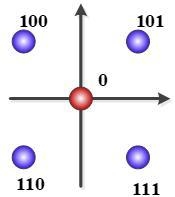Orbital Angular Momentum Multiplexed Free-Space Optical Communication Systems Based on Coded Modulation
Abstract
:1. Introduction
2. Adaptive Optics Enabled Free-Space Optical Communication
2.1. Experimental Setup
2.2. Results and Analysis
3. Joint Huffman and LDPC Coding Enabled Free-Space Optical Communication
3.1. Experimental Setup
3.2. Results and Analysis
4. Concluding Remarks
Author Contributions
Funding
Conflicts of Interest
References
- Qu, Z.; Li, Y.; Mo, W.; Yang, M.; Zhu, S.; Kilper, D.; Djordjevic, I.B. Performance optimization of PM-16QAM transmission system enabled by real-time self-adaptive coding. Opt. Lett. 2017, 42, 4211–4214. [Google Scholar] [CrossRef] [PubMed]
- Ip, E.; Lau, A.P.T.; Barros, D.J.F.; Kahn, J.M. Coherent detection in optical fiber systems. Opt. Express 2008, 16, 753–791. [Google Scholar] [CrossRef] [PubMed]
- Khalighi, M.A.; Uysal, M. Survey on free space optical communication: A communication theory perspective. IEEE Commun. Surv. Tutor. 2014, 16, 2231–2258. [Google Scholar] [CrossRef]
- Qu, Z.; Djordjevic, I.B. Experimental evaluation of LDPC-coded OAM based FSO communication in the presence of atmospheric turbulence. In Proceedings of the 12th International Conference on Telecommunications in Modern Satellite, Cable and Broadcasting Services (TELSIKS), Nis, Serbia, 14–17 October 2015; pp. 117–122. [Google Scholar]
- Djordjevic, I.B.; Qu, Z. Coded Orbital Angular Momentum Modulation and Multiplexing Enabling Ultra-High-Speed Free-Space Optical Transmission. In Optical Wireless Communications Signals and Communication Technology; Uysal, M., Capsoni, C., Ghassemlooy, Z., Boucouvalas, A., Udvary, E., Eds.; Springer: Cham, Switzerland, 2016; pp. 363–385. ISBN 978-3-319-30200-3. [Google Scholar]
- Yue, Y.; Huang, H.; Ahmed, N.; Yan, Y.; Ren, Y.; Xie, G.; Rogawski, D.; Tur, M.; Willner, A.E. Reconfigurable switching of orbital-angular-momentum-based free-space data channels. Opt. Lett. 2013, 38, 5118–5121. [Google Scholar] [CrossRef] [PubMed]
- Jurado-Navas, A.; Tatarczak, A.; Lu, X.; Olmos, J.J.; Garrido-Balsells, J.M.; Monroy, I.T. 850-nm hybrid fiber/free-space optical communications using orbital angular momentum modes. Opt. Express 2015, 23, 33721–33732. [Google Scholar] [CrossRef] [PubMed]
- Xie, Y.; Geng, Z.; Kong, D.; Zhuang, L.; Lowery, A.J. Selectable-FSR 10-GHz granularity WDM superchannel filter in a reconfigurable photonic integrated circuit. J. Lightw. Technol. 2018, 36, 2619–2626. [Google Scholar] [CrossRef]
- Xie, Y.; Geng, Z.; Zhuang, L.; Burla, M.; Taddei, C.; Hoekman, M.; Leinse, A.; Roeloffzen, C.G.; Boller, K.J.; Lowery, A.J. Programmable optical processor chips: Toward photonic RF filters with DSP-level flexibility and MHz-band selectivity. Nanophotonics 2017, 7, 421–454. [Google Scholar] [CrossRef]
- Lowery, A.J.; Xie, Y.; Zhu, C. Systems performance comparison of three all-optical generation schemes for quasi-Nyquist WDM. Opt. Express 2015, 23, 21706–21718. [Google Scholar] [CrossRef] [PubMed]
- Qu, Z.; Zhang, S.; Djordjevic, I.B. Universal Hybrid Probabilistic-geometric Shaping Based on Two-dimensional Distribution Matchers. In Proceedings of the Optical Fiber Communication Conference (OFC), San Diego, CA, USA, 11–15 March 2018. [Google Scholar]
- Zhang, S.; Qu, Z.; Yaman, F.; Mateo, E.; Inoue, T.; Nakamura, K.; Inada, Y.; Djordjevic, I.B. Flex-Rate Transmission using Hybrid Probabilistic and Geometric Shaped 32QAM. In Proceedings of the Optical Fiber Communication Conference (OFC), San Diego, CA, USA, 11–15 March 2018. [Google Scholar]
- Lin, C.; Qu, Z.; Liu, T.; Zou, D.; Djordjevic, I.B. Experimental study of capacity approaching general LDPC coded non-uniform shaping modulation format. In Proceedings of the Asia Communications and Photonics Conference (ACP), Wuhan, China, 2–5 November 2016. [Google Scholar]
- Wang, J.; Yang, J.Y.; Fazal, I.M.; Ahmed, N.; Yan, Y.; Huang, H.; Ren, Y.; Yue, Y.; Dolinar, S.; Tur, M.; et al. Terabit free-space data transmission employing orbital angular momentum multiplexing. Nat. Photonics 2012, 6, 488–496. [Google Scholar] [CrossRef]
- Djordjevic, I.B.; Qu, Z. Coded Orbital-Angular-Momentum-Based Free-Space Optical Transmission; Wiley Encyclopedia of Electrical and Electronics Engineering: Hoboken, NJ, USA, 2016. [Google Scholar]
- Willner, A.E.; Huang, H.; Yan, Y.; Ren, Y.; Ahmed, N.; Xie, G.; Bao, C.; Li, L.; Cao, Y.; Zhao, Z.; et al. Optical communications using orbital angular momentum beams. Adv. Opt. Photonics 2015, 7, 66–106. [Google Scholar] [CrossRef]
- Allen, L.; Beijersbergen, M.W.; Spreeuw, R.J.C.; Woerdman, J.P. Orbital angular momentum of light and the transformation of Laguerre-Gaussian laser modes. Phys. Rev. A 1992, 45, 8185. [Google Scholar] [CrossRef] [PubMed]
- Zhang, Y.; Shan, L.; Li, Y.; Yu, L. Effects of moderate to strong turbulence on the Hankel-Bessel-Gaussian pulse beam with orbital angular momentum in the marine-atmosphere. Opt. Express 2017, 25, 33469–33479. [Google Scholar] [CrossRef]
- Qu, Z.; Djordjevic, I.B. Beyond 1 Tb/s free-space optical transmission in the presence of atmospheric turbulence. In Proceedings of the Photonics North (PN), Ottawa, ON, Canada, 6–8 June 2017. [Google Scholar]
- Ren, Y.; Huang, H.; Xie, G.; Ahmed, N.; Yan, Y.; Erkmen, B.I.; Chandrasekaran, N.; Lavery, M.P.; Steinhoff, N.K.; Tur, M.; et al. Atmospheric turbulence effects on the performance of a free space optical link employing orbital angular momentum multiplexing. Opt. Lett. 2013, 38, 4062–4065. [Google Scholar] [CrossRef] [PubMed]
- Ren, Y.; Xie, G.; Huang, H.; Li, L.; Ahmed, N.; Yan, Y.; Lavery, M.P.; Bock, R.; Tur, M.; Neifeld, M.A.; et al. Turbulence compensation of an orbital angular momentum and polarization-multiplexed link using a data-carrying beacon on a separate wavelength. Opt. Lett. 2015, 40, 2249–2252. [Google Scholar] [CrossRef] [PubMed]
- Qu, Z.; Djordjevic, I.B. 500 Gb/s free-space optical transmission over strong atmospheric turbulence channels. Opt. Lett. 2016, 41, 3285–3288. [Google Scholar] [CrossRef] [PubMed]
- Li, S.; Wang, J. Adaptive free-space optical communications through turbulence using self-healing Bessel beams. Sci. Rep. 2017, 7, 43233. [Google Scholar] [CrossRef] [PubMed] [Green Version]
- Huang, H.; Cao, Y.; Xie, G.; Ren, Y.; Yan, Y.; Bao, C.; Ahmed, N.; Neifeld, M.A.; Dolinar, S.J.; Willner, A.E. Crosstalk mitigation in a free-space orbital angular momentum multiplexed communication link using 4× 4 MIMO equalization. Opt. Lett. 2014, 39, 4360–4363. [Google Scholar] [CrossRef] [PubMed]
- Ren, Y.; Wang, Z.; Xie, G.; Li, L.; Cao, Y.; Liu, C.; Liao, P.; Yan, Y.; Ahmed, N.; Zhao, Z.; et al. Free-space optical communications using orbital-angular-momentum multiplexing combined with MIMO-based spatial multiplexing. Opt. Lett. 2015, 40, 4210–4213. [Google Scholar] [CrossRef] [PubMed]
- Dabiri, M.T.; Saber, M.J.; Sadough, S.M.S. On the performance of multiplexing FSO MIMO links in log-normal fading with pointing errors. J. Opt. Commun. Netw. 2017, 9, 974–983. [Google Scholar] [CrossRef]
- Qu, Z.; Djordjevic, I.B. Coded orbital angular momentum based free-space optical transmission in the presence of atmospheric turbulence. In Proceedings of the Asia Communications and Photonics Conference (ACP), Hong Kong, China, 19–23 November 2015. [Google Scholar]
- Kaushal, H.; Kaddoum, G. Optical communication in space: Challenges and mitigation techniques. IEEE Commun. Surv. Tutor. 2017, 19, 57–96. [Google Scholar] [CrossRef]
- Qu, Z.; Djordjevic, I.B. Approaching terabit optical transmission over strong atmospheric turbulence channels. In Proceedings of the 18th International Conference on Transparent Optical Networks (ICTON), Trento, Italy, 10–14 July 2016; pp. 1–5. [Google Scholar]
- Liu, T.; Qu, Z.; Lin, C.; Djordjevic, I.B. Nonuniform signaling based LDPC-coded modulation for high-speed optical transport networks. In Proceedings of the Asia Communications and Photonics Conference (ACP), Wuhan, China, 2–5 November 2016. [Google Scholar]
- Qu, Z.; Lin, C.; Liu, T.; Djordjevic, I.B. Experimental study of nonlinearity tolerant modulation formats based on LDPC coded non-uniform signaling. In Proceedings of the Optical Fiber Communication Conference (OFC), Los Angeles, CA, USA, 19–23 March 2017. [Google Scholar]
- Andrews, L.C.; Phillips, R.L.; Hopen, C.Y. Laser Beam Scintillation with Applications; SPIE Press: Bellingham, WA, USA, 2001; ISBN 9781510604896. [Google Scholar]
- Dong, B.; Ren, D.Q.; Zhang, X. Stochastic parallel gradient descent based adaptive optics used for a high contrast imaging coronagraph. Res. Astron. Astrophys. 2011, 11, 997. [Google Scholar] [CrossRef]
- Hu, X.Y.; Eleftheriou, E.; Arnold, D.M.; Dholakia, A. Efficient implementations of the sum-product algorithm for decoding LDPC codes. In Proceedings of the Global Telecommunications Conference, San Antonio, TX, USA, 25–29 November 2001. [Google Scholar] [Green Version]
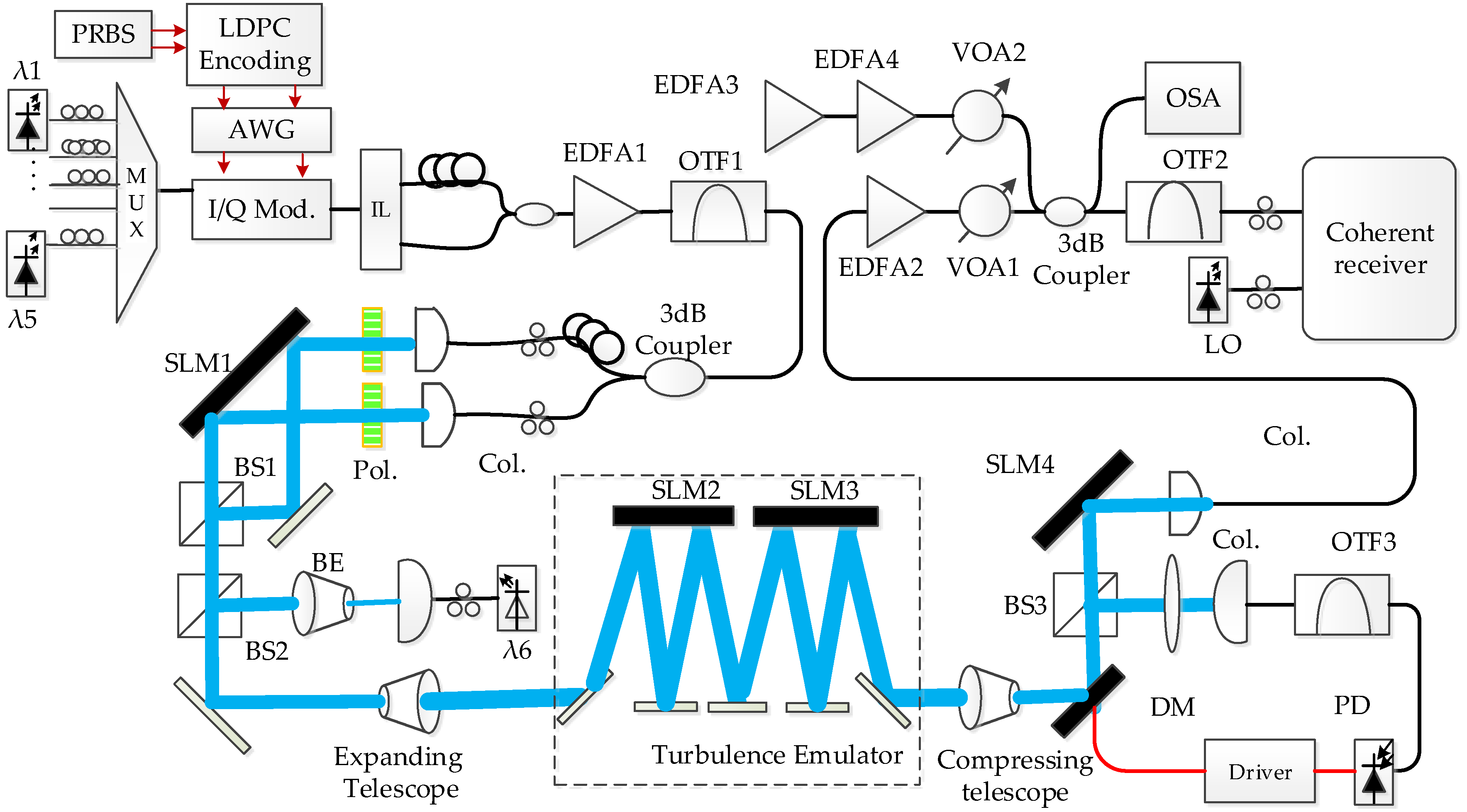
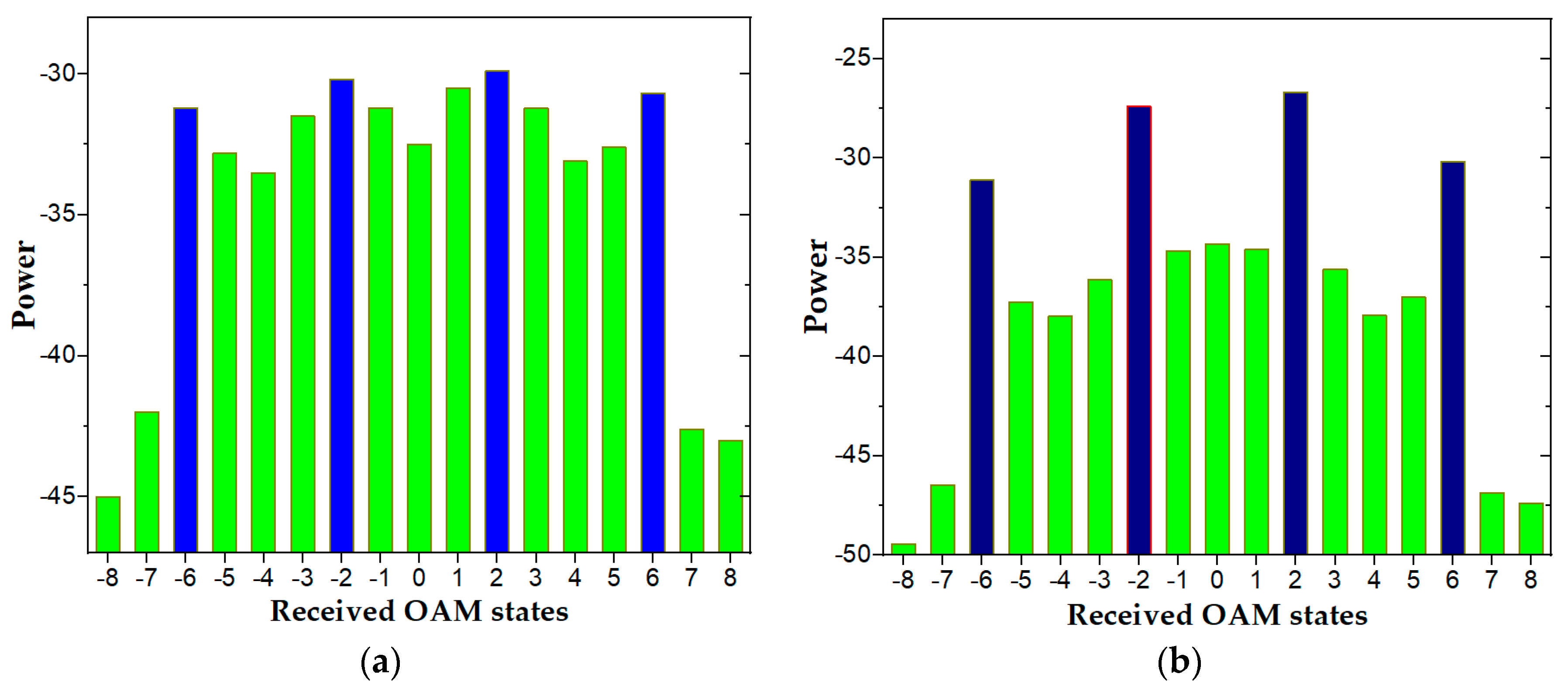
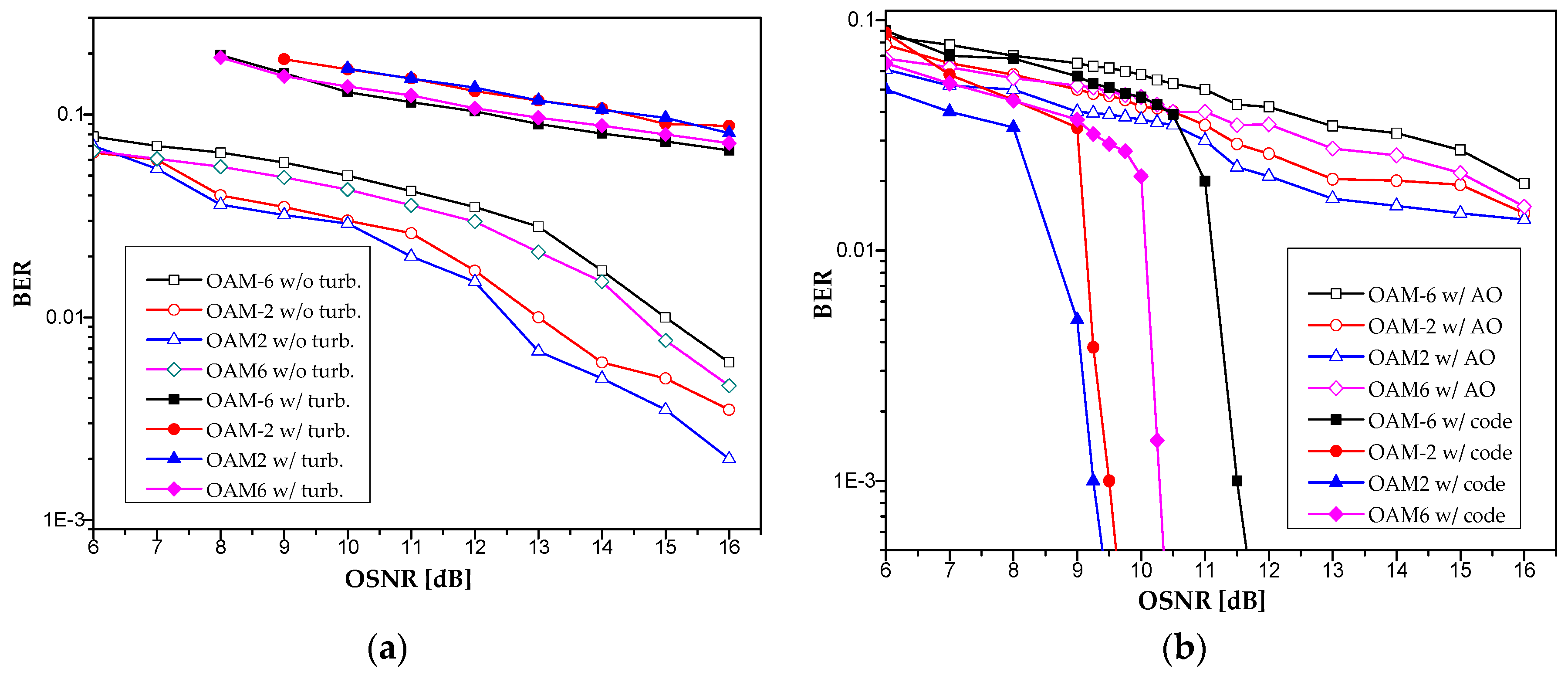
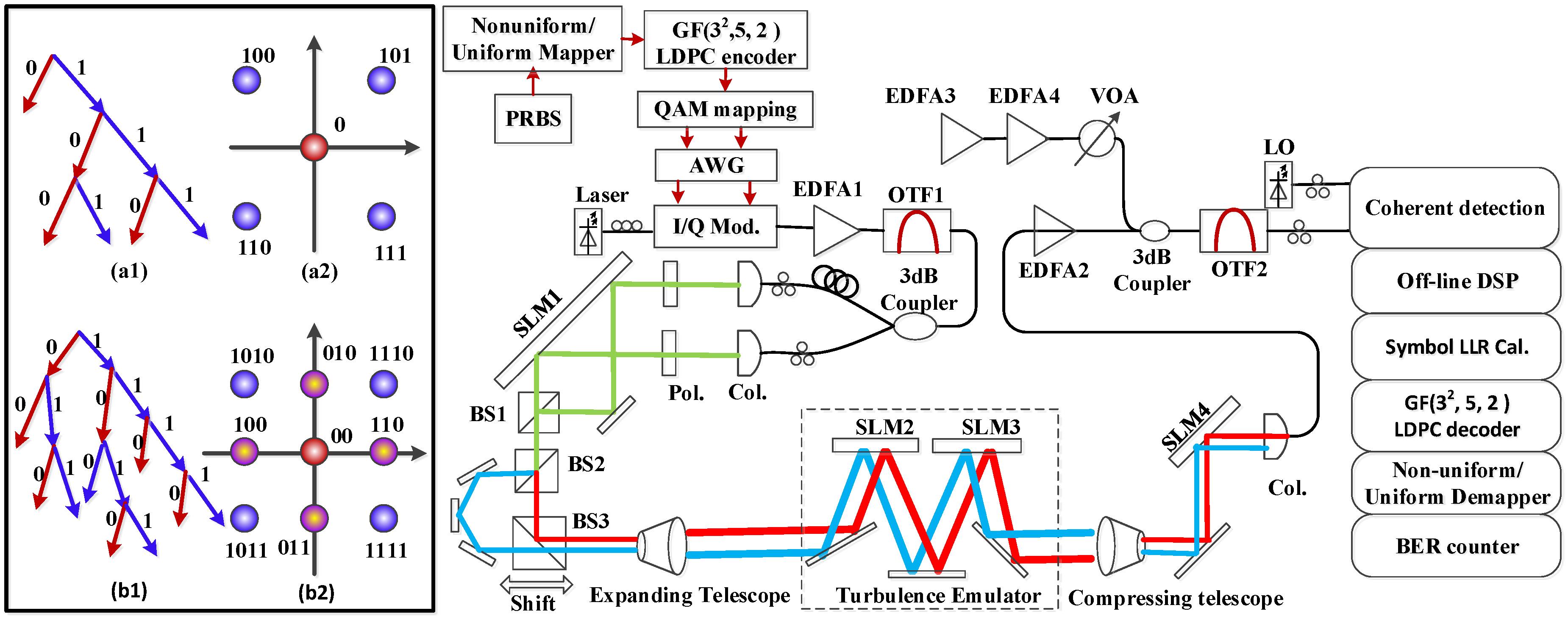
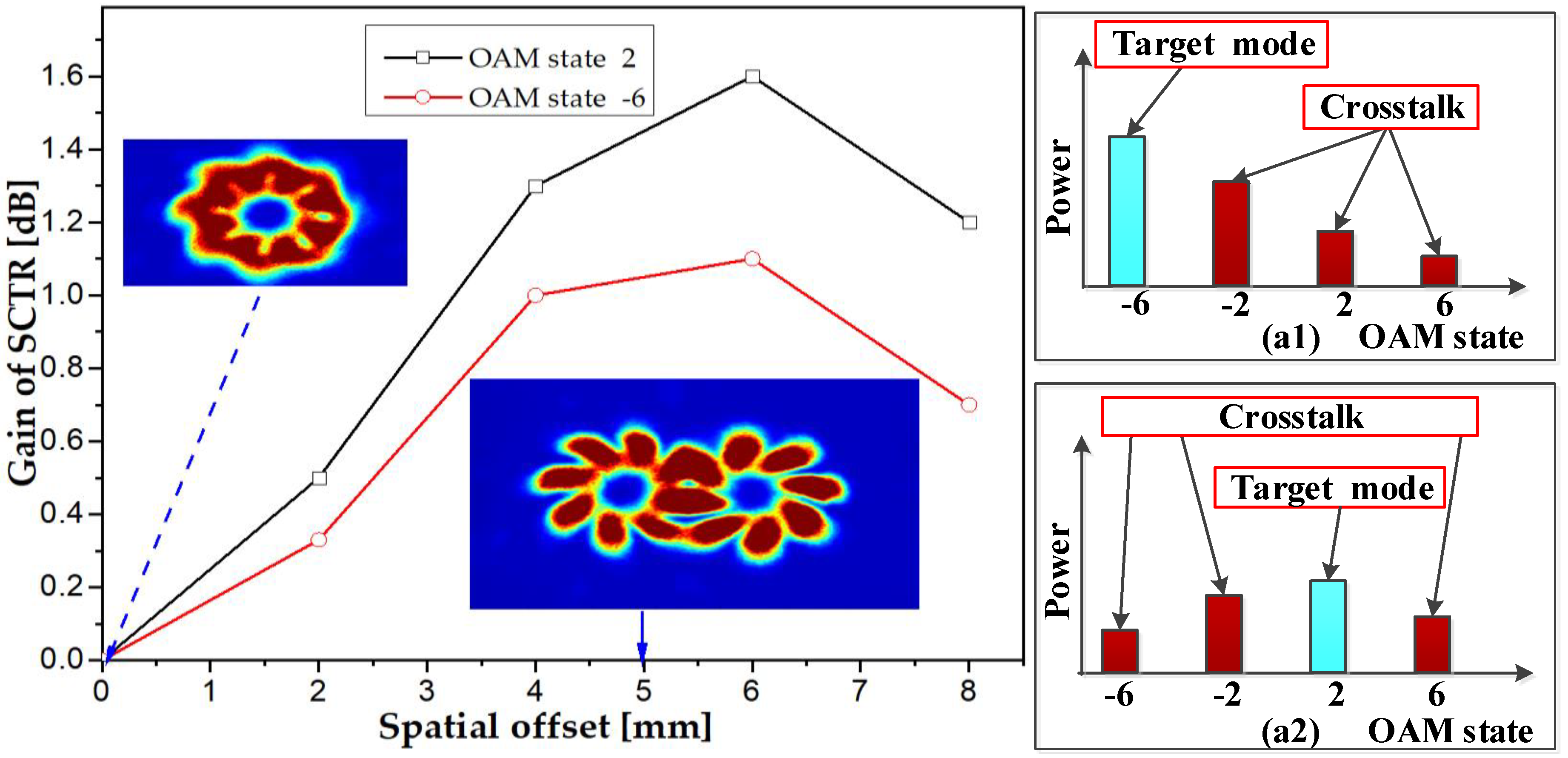
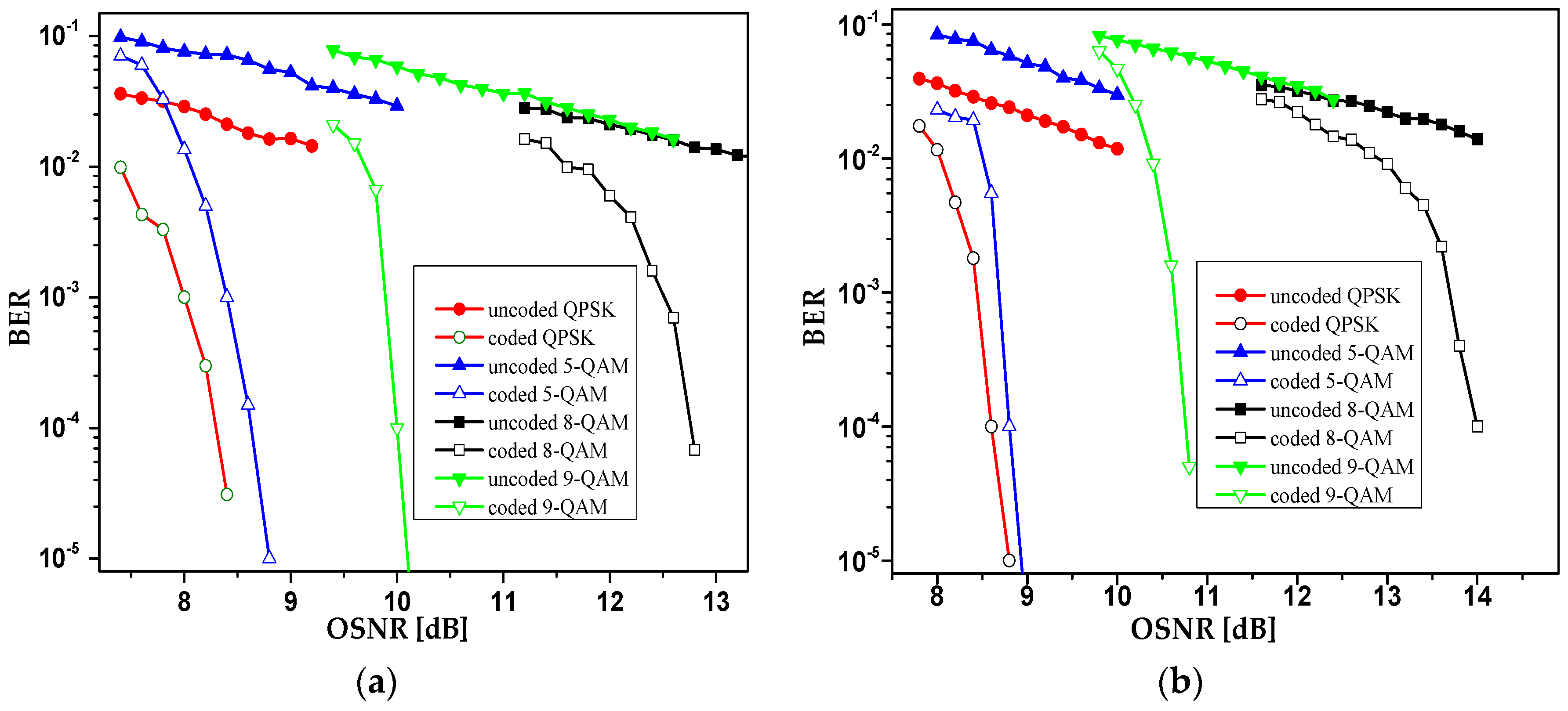
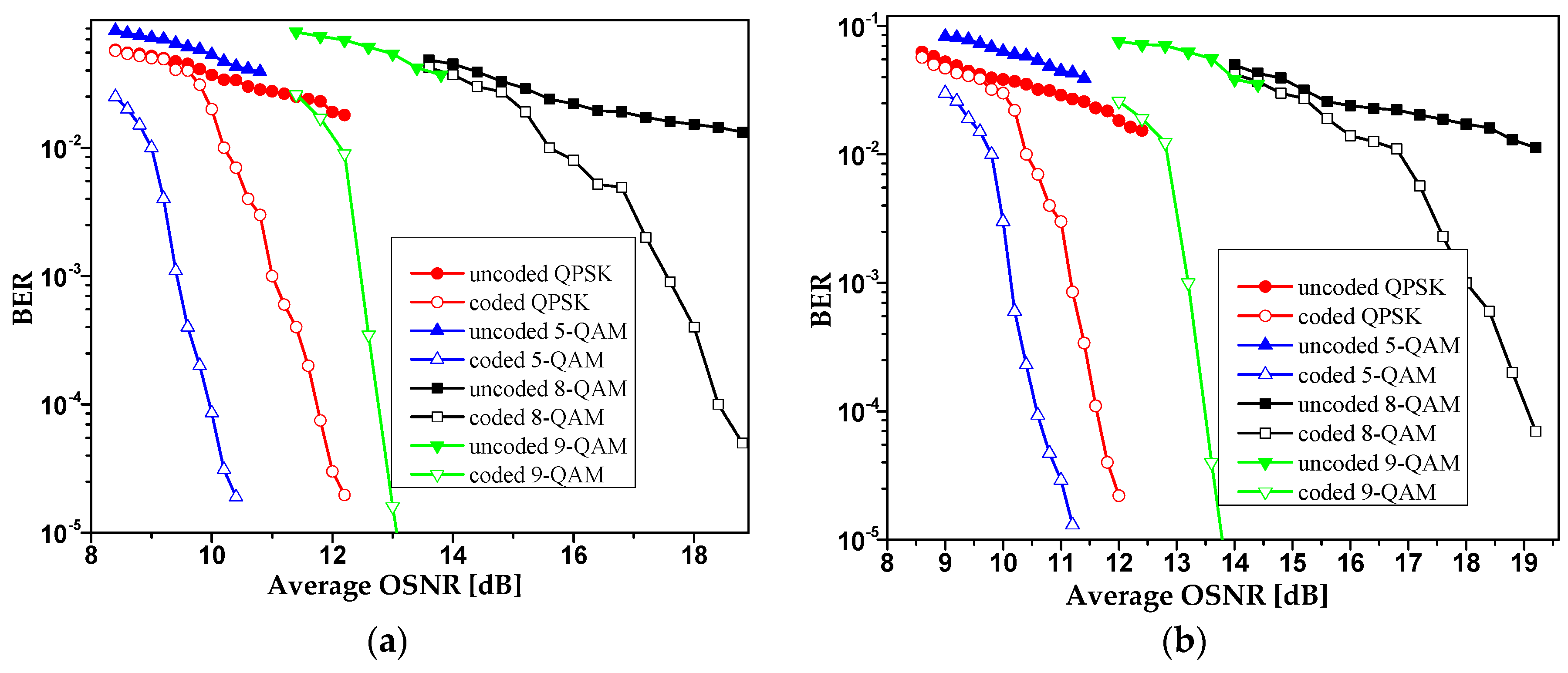
| Modulation Formats | QPSK | 5-QAM | 8-QAM | 9-QAM | |
|---|---|---|---|---|---|
| Without turbulence | OAM state 2 | 8.3 dB | 8.6 dB | 12.7 dB | 10 dB |
| OAM state 6 | 8.6 dB | 8.8 dB | 14.0 dB | 10.8 dB | |
| With turbulence | OAM state 2 | 11.6 dB | 10 dB | 18.4 dB | 12.8 dB |
| OAM state 6 | 11.7 dB | 10.6 dB | 19.0 dB | 13.6 dB |
© 2018 by the authors. Licensee MDPI, Basel, Switzerland. This article is an open access article distributed under the terms and conditions of the Creative Commons Attribution (CC BY) license (http://creativecommons.org/licenses/by/4.0/).
Share and Cite
Qu, Z.; Djordjevic, I.B. Orbital Angular Momentum Multiplexed Free-Space Optical Communication Systems Based on Coded Modulation. Appl. Sci. 2018, 8, 2179. https://doi.org/10.3390/app8112179
Qu Z, Djordjevic IB. Orbital Angular Momentum Multiplexed Free-Space Optical Communication Systems Based on Coded Modulation. Applied Sciences. 2018; 8(11):2179. https://doi.org/10.3390/app8112179
Chicago/Turabian StyleQu, Zhen, and Ivan B. Djordjevic. 2018. "Orbital Angular Momentum Multiplexed Free-Space Optical Communication Systems Based on Coded Modulation" Applied Sciences 8, no. 11: 2179. https://doi.org/10.3390/app8112179
APA StyleQu, Z., & Djordjevic, I. B. (2018). Orbital Angular Momentum Multiplexed Free-Space Optical Communication Systems Based on Coded Modulation. Applied Sciences, 8(11), 2179. https://doi.org/10.3390/app8112179





